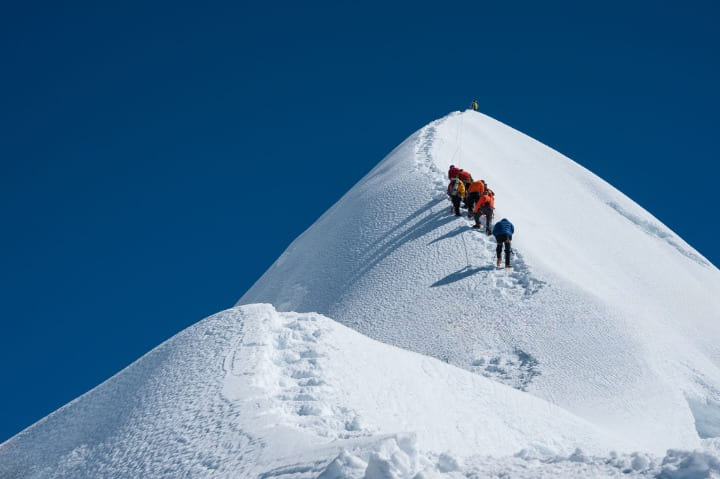Island Peak climbing difficulty is a major consideration for adventurers planning to summit this iconic Himalayan trekking peak. Standing at 6,189 meters (20,305 feet), Island Peak also known as Imja Tse offers not only breathtaking views but also a real test of endurance, technique, and preparation. While often labeled as a “trekking peak,” Island Peak demands more than just a hiking experience. It blends technical ice and rock climbing with high-altitude challenges, making it crucial to understand what you’re signing up for.
Understanding Island Peak Climbing Difficulty
Despite being one of the most popular trekking peaks in Nepal, Island Peak’s climbing difficulty should not be underestimated. The name might evoke images of a tranquil island, but the terrain and environment are anything but gentle. The ascent involves glacier travel, steep snow and ice walls, and crevasse navigation components that elevate its status to more than a simple trekking experience.
Key Challenges That Define Island Peak Climbing Difficulty
High Altitude Exposure
Altitude is one of the biggest challenges. The summit lies well within the zone where altitude sickness becomes a real threat. Acute Mountain Sickness (AMS) can occur even before reaching base camp at 5,087 meters. Proper acclimatization and gradual ascent are crucial.
Technical Climbing Sections
While the initial trail resembles a standard Himalayan trek, the final push to the summit involves a headwall of approximately 100 meters with an incline of 45-50 degrees. Fixed ropes are used, and climbers need to harness their knowledge of jumars, rappelling, and crampons.
Weather Conditions
Island Peak is subject to rapidly changing Himalayan weather. Sudden snowfalls, fierce winds, and sub-zero temperatures can turn a manageable climb into a perilous challenge within hours.
Physical Endurance and Stamina
Climbing Island Peak is physically demanding. Days can last over 10 hours, especially the summit day. A solid base of cardiovascular fitness and muscular endurance is essential for both the ascent and descent.
Island Peak Climbing Difficulty by Route Sections
Trek to Base Camp
This part of the journey mirrors the classic Everest Base Camp trail up to Chhukung. While not overly difficult, it requires long walking days and stamina.
Base Camp to High Camp
The trail becomes steeper, and you’ll traverse rocky moraines. It’s the start of your technical experience but manageable for fit trekkers.
High Camp to Summit
Here’s where things get tough. Pre-dawn starts are common, with hours of glacier walking, ladder crossings, and ice climbing. The headwall and summit ridge test every climber’s technical and mental resilience.
Is Island Peak Climbing Difficulty Suitable for Beginners?
Technically, yes but only with the right preparation. Beginners must have:
- Previous high-altitude trekking experience
- Basic mountaineering training (using crampons, ice axe, and fixed ropes)
- Excellent fitness levels
- Guided expeditions with experienced Sherpas
Without these, the Island Peak climbing difficulty could overwhelm even the most enthusiastic novice.
Acclimatization and Preparation Tips
- Follow a slow itinerary with 2–3 acclimatization days
- Train at high intensity 3–4 months before departure
- Join mountaineering courses for rope work and ice climbing
- Invest in good gear and familiarize yourself with it before the trip
- Hydrate and eat well during the climb
Best Season to Tackle Island Peak Climbing Difficulty
The best climbing windows are:
- Spring (April-May): Stable weather and clear skies
- Autumn (October-November): Post-monsoon clarity and cooler conditions
Avoid the monsoon (June-August) and deep winter (December-February), when the peak becomes significantly more dangerous.
Guided Expedition vs. Solo Attempt
Going solo is strongly discouraged. A guided expedition provides:
- Safety through fixed ropes and expert route finding
- High-altitude medical support
- Logistic support including food, permits, and gear
- Local knowledge and motivation from Sherpas
Given the technical aspects and potential hazards, a guided trip significantly reduces the risks involved with the Island Peak climbing difficulty.
Essential Gear Checklist for Island Peak
- Insulated climbing boots
- Crampons and ice axe
- Harness, helmet, carabiners
- Jumar and Belay devices
- High-altitude sleeping bag
- Down jacket and waterproof shell
- Headlamp with extra batteries
- Glacier sunglasses and sunscreen
Final Thoughts on Island Peak Climbing Difficulty
Island Peak offers a thrilling mix of trekking and technical mountaineering. While it is achievable for those with determination, preparation, and proper support, it is by no means an easy climb. Respect the mountain, train adequately, and choose a reliable expedition company to make your Island Peak dream a reality.
FAQs
How technical is Island Peak’s climbing difficulty?
The final summit section requires technical skills such as fixed rope climbing, crampon use, and abseiling. It’s a mix of glacier travel and steep ascents.
Can a beginner climb Island Peak?
Yes, but only with prior trekking experience, basic mountaineering training, and a reputable guide or climbing agency.
What is the success rate of Island Peak climbs?
Generally, the high is around 70-85% when climbers are well-prepared and climb during the ideal season.
Is Island Peak harder than the Everest Base Camp trek?
Yes. While EBC is a long trek, Island Peak involves technical climbing, high altitude, and glacier travel.
What is the best way to train for Island Peak?
Focus on cardio (hiking, running), strength training, and high-altitude acclimatization hikes. Add technical climbing practice for rope work and glacier skills.
How long does it take to climb Island Peak?
From Kathmandu and back, the expedition typically takes around 17–20 days, depending on acclimatization and weather.


